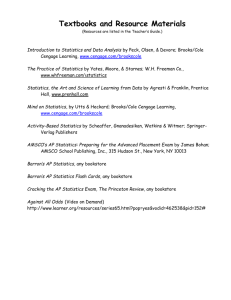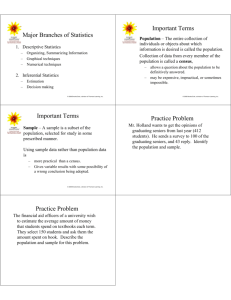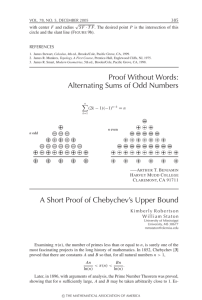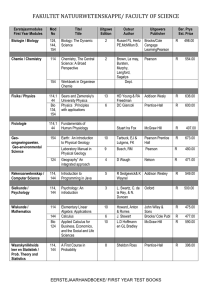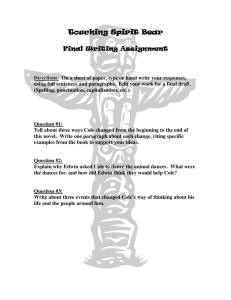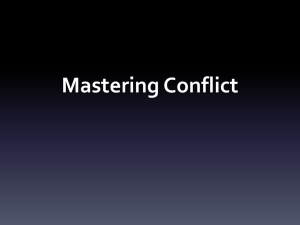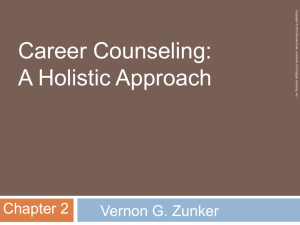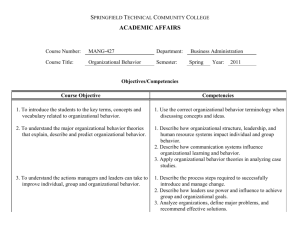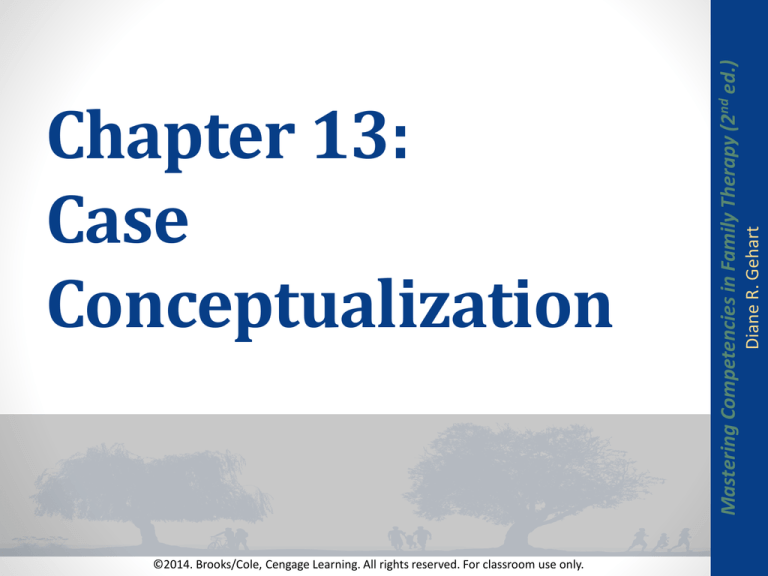
©2014. Brooks/Cole, Cengage Learning. All rights reserved. For classroom use only.
Diane R. Gehart
Mastering Competencies in Family Therapy (2nd ed.)
Chapter 13:
Case
Conceptualization
• Necessary to develop a good map.
• Refers to knowing where to focus your attention while you are
listening.
• A skill that is continually developed and refined throughout one’s
career.
• Case conceptualization
• Technical term for the therapeutic art of viewing.
• Sometimes called assessment.
• Enables therapists to generate new perspectives, which enable
them to be helpful to clients.
©2014. Brooks/Cole, Cengage Learning. All rights reserved. For classroom use only.
Diane R. Gehart
• Master the art of viewing.
Mastering Competencies in Family Therapy (2nd ed.)
Mapping the Territory (Step 1)
•
•
•
•
•
•
•
•
•
•
Introduction to client
Presenting concern
Background information
Client/family strengths and diversity
Family structure
Interactional pattern
Intergenerational and attachment patterns
Solution-based assessment
Postmodern and cultural discourse conceptualization
Client perspectives
©2014. Brooks/Cole, Cengage Learning. All rights reserved. For classroom use only.
Diane R. Gehart
• Components of a systemic case conceptualization:
Mastering Competencies in Family Therapy (2nd ed.)
Overview of Case
Conceptualization
• Individual
• Couple
• Family
• Identifying most salient demographic features that relate to
treatment:
•
•
•
•
•
Age
Ethnicity
Gender
Sexual orientation/HIV status
Current occupation (work status/grade in school)
©2014. Brooks/Cole, Cengage Learning. All rights reserved. For classroom use only.
Diane R. Gehart
• Identifying who the client is.
Mastering Competencies in Family Therapy (2nd ed.)
Introduction to Client
• Each person involved has a different definition of the problem.
• Allows therapist to remain adaptable and creative.
• Honor each person’s perspective and refer to it throughout
treatment.
• Should include:
• Reason each client states he/she is in counseling or why referred.
• Information from referring agent and their description of
problem.
• A brief history of the problem and family.
• Descriptions of attempted solutions and outcomes.
• Any other relevant problem related information.
©2014. Brooks/Cole, Cengage Learning. All rights reserved. For classroom use only.
Diane R. Gehart
• How all parties involved are defining the problem.
• Collaborative therapy
Mastering Competencies in Family Therapy (2nd ed.)
Presenting Concern
•
•
•
•
History of trauma and abuse
Substance use and abuse
Precipitating events
Related historical background
• Recommended that this information be written in a positive
and hopeful light.
©2014. Brooks/Cole, Cengage Learning. All rights reserved. For classroom use only.
Diane R. Gehart
• Traditionally included is:
Mastering Competencies in Family Therapy (2nd ed.)
Background Information
• Can include strengths at several levels:
• Personal/individual strengths
• Relational/social strengths and resources
• Spiritual resources
©2014. Brooks/Cole, Cengage Learning. All rights reserved. For classroom use only.
Diane R. Gehart
• Should be the first thing assessed.
Mastering Competencies in Family Therapy (2nd ed.)
Strengths and Diversity
Resources
• Consider past, present, and future.
• Can increase client’s sense of hope and confidence to address the
issue at hand.
• May provide creative problem solving ideas.
• Personal qualities
• What brings client’s to therapy is usually flip side of a strength.
• Ex. Someone who worries too much is likely a diligent and productive
worker.
©2014. Brooks/Cole, Cengage Learning. All rights reserved. For classroom use only.
Diane R. Gehart
• Abilities
Mastering Competencies in Family Therapy (2nd ed.)
Personal or Individual Strengths
•
•
•
•
Physical
Emotional
Community
Spiritual
©2014. Brooks/Cole, Cengage Learning. All rights reserved. For classroom use only.
Diane R. Gehart
• Social support network that helps client in various ways.
Mastering Competencies in Family Therapy (2nd ed.)
Relational or Social Strengths and
Resources
•
•
•
•
•
Strong support network
Sense of community and connection, purpose and direction
Resources for problem-solving
Beliefs that provide comfort
Access to social services
• Common limitations due to diversity:
•
•
•
•
•
Experiences of harassment/discrimination
Isolation/difficulty meeting others
Difficulty finding opportunity and accessing services
Difficulty communicating with institutions
Lack of resources
©2014. Brooks/Cole, Cengage Learning. All rights reserved. For classroom use only.
Diane R. Gehart
• Common resources due to diversity:
Mastering Competencies in Family Therapy (2nd ed.)
Diversity Resources and
Limitations
•
•
•
•
•
•
Family life cycle stage
Boundaries
Triangles/coalitions
Hierarchy between parents and children
Satir’s communication stances
Gottman’s divorce indicators
©2014. Brooks/Cole, Cengage Learning. All rights reserved. For classroom use only.
Diane R. Gehart
• Can be used with individuals, couples or families.
• Includes:
Mastering Competencies in Family Therapy (2nd ed.)
Family Structure
• Assessment of family structure often begins with this.
• The stages include:
•
•
•
•
•
•
•
•
Leaving home — the single adult
Committed relationship
Families with young children
Families with adolescent children
Divorce
Blended families
Launching children
Family in later life
©2014. Brooks/Cole, Cengage Learning. All rights reserved. For classroom use only.
Diane R. Gehart
• Family life cycle stage
Mastering Competencies in Family Therapy (2nd ed.)
Family Life Cycle
• Most commonly associated with structural family
therapy.
• The rules for negotiating interpersonal closeness and
distance.
• Strongly influenced by culture.
• Can be clear, diffuse, or rigid.
©2014. Brooks/Cole, Cengage Learning. All rights reserved. For classroom use only.
Diane R. Gehart
• Boundaries regulate closeness and distance.
Mastering Competencies in Family Therapy (2nd ed.)
Boundaries
• Negotiation of a healthy balance between closeness and
separation.
• Collectivist cultures: More closeness.
• Individualistic cultures: Value greater independence.
Diffuse boundaries and enmeshed relationships
• When couples or families overvalue togetherness at the expense
of respecting each other’s individuality.
Rigid boundaries
• When couples or families privilege independence over
togetherness.
©2014. Brooks/Cole, Cengage Learning. All rights reserved. For classroom use only.
Diane R. Gehart
Clear boundaries and cultural variance
Mastering Competencies in Family Therapy (2nd ed.)
Boundaries
• May include inanimate objects or processes as “third”
• Ex.: Drinking, drug use, work
• Assessed in several ways:
•
•
•
•
Client overtly describes another as playing role in their tension.
Description of a confidant.
Finding an unmet need in a third party.
When therapy is “stuck,” there is often a triangle at work.
©2014. Brooks/Cole, Cengage Learning. All rights reserved. For classroom use only.
Diane R. Gehart
• Tension between two people is resolved by drawing in a third
person to stabilize the original dyad.
Mastering Competencies in Family Therapy (2nd ed.)
Triangles and Coalitions
•
•
•
•
Excessive
Insufficient
Effective
Inconsistent
• Can be helpful to consider the balance of roles
within the parental subsystem.
• Business roles
• Personal roles
©2014. Brooks/Cole, Cengage Learning. All rights reserved. For classroom use only.
Diane R. Gehart
• Is hierarchy developmentally and culturally
appropriate?
• Assessing hierarchy tell therapists where and how to
intervene.
Mastering Competencies in Family Therapy (2nd ed.)
Hierarchy Between Child and Parent
• Each person takes on opposite or
complementary ranging from functional to
problematic.
• Ex.: Pursuer/distancer, emotional/logical
• Most couples readily identify complementary
roles in their complaints about the
relationship.
©2014. Brooks/Cole, Cengage Learning. All rights reserved. For classroom use only.
Diane R. Gehart
• Complementary patterns
Mastering Competencies in Family Therapy (2nd ed.)
Complementary Patterns
• Placating
• Blaming
• Superreasonable
• Irrelevant
• Congruent
©2014. Brooks/Cole, Cengage Learning. All rights reserved. For classroom use only.
Diane R. Gehart
• An approach for assessing communication.
• Based on five communication stances:
Mastering Competencies in Family Therapy (2nd ed.)
Satir’s Communication Stances
• Model for healthy communication.
• Other four are survival stances.
• Each stance recognizes different elements
of self, other, and context.
©2014. Brooks/Cole, Cengage Learning. All rights reserved. For classroom use only.
Diane R. Gehart
• Congruent
Mastering Competencies in Family Therapy (2nd ed.)
Satir’s Communication Stances
Recognizes
Congruent
Self, other, context
None
Placator
Other, context
Self
Blamer
Self, context
Other
Superreasonable
Context
Self, other
Irrelevant
None
Self, other, context
I
Ignores
©2014. Brooks/Cole, Cengage Learning. All rights reserved. For classroom use only.
Diane R. Gehart
Style
Mastering Competencies in Family Therapy (2nd ed.)
Satir’s Communication Stances
• Over 30 years research on couples and
communication.
• Can predict divorce with 97.5% accuracy by
assessing 5 variables (Four Horsemen and repair
attempts).
• The Four Horseman of the Apocalypse:
•
•
•
•
Criticism
Defensiveness
Contempt
Stonewalling
©2014. Brooks/Cole, Cengage Learning. All rights reserved. For classroom use only.
Diane R. Gehart
• John Gottman
Mastering Competencies in Family Therapy (2nd ed.)
Gottman’s Divorce Indicators
• 5:1 ratio
• Interactions to assess for frequency
include:
• Failed repair attempts
• Rejection of influence
• Harsh start-up
©2014. Brooks/Cole, Cengage Learning. All rights reserved. For classroom use only.
Diane R. Gehart
• Presence of “Four Horsemen” not only
indicator; frequency of these differs in
happy couples.
Mastering Competencies in Family Therapy (2nd ed.)
Gottman’s Divorce Indicators
• Ex.: How person A responds to person B and
vice versa.
• Three phases:
• Start of tension
• Conflict/symptom escalation
• Return to normal/homeostasis
©2014. Brooks/Cole, Cengage Learning. All rights reserved. For classroom use only.
Diane R. Gehart
• One of hallmarks of family therapy.
• Therapist traces reciprocal relation
patterns.
Mastering Competencies in Family Therapy (2nd ed.)
Problem Interaction Patterns
• Working hypothesis about problem.
• Role symptom plays in maintaining
homeostasis.
• Strategies for developing hypotheses:
• Client language and metaphors
• Positive connotation
• Love and power
©2014. Brooks/Cole, Cengage Learning. All rights reserved. For classroom use only.
Diane R. Gehart
• Developed after assessing family structure
and interaction patterns.
Mastering Competencies in Family Therapy (2nd ed.)
Systemic Hypothesis
•
•
•
•
Family strengths and resources
Substance and alcohol abuse and dependence
Sexual, physical, and emotional abuse
Personal qualities and/or family roles; complementary roles (e.g.,
black sheep, rebellious one, overachiever/underachiever, etc.)
• Physical and mental health issues (e.g., diabetes, cancer,
depression, psychosis, etc.)
• Historical incidents of the presenting problem, either with the
same people or how other generations and family members have
managed this problem
©2014. Brooks/Cole, Cengage Learning. All rights reserved. For classroom use only.
Diane R. Gehart
• Easiest when using a genogram.
• Patterns often included in genograms:
Mastering Competencies in Family Therapy (2nd ed.)
Intergenerational Patterns
• Secure
• Anxious and hyperactivated
• Avoidance
• Combination anxious and avoidant
©2014. Brooks/Cole, Cengage Learning. All rights reserved. For classroom use only.
Diane R. Gehart
• Often central in psychodynamic and EFT
approaches.
• Sue Johnson indicates four categories of
attachment:
Mastering Competencies in Family Therapy (2nd ed.)
Attachment Patterns
• Address previous solutions that did work.
• Exceptions and unique outcomes.
• Difficult because most clients are unaware of when the
problem was not a problem.
• Miracle question
©2014. Brooks/Cole, Cengage Learning. All rights reserved. For classroom use only.
Diane R. Gehart
• Address previous solutions that did not work.
Mastering Competencies in Family Therapy (2nd ed.)
Solution-Based Assessment
• Dominant discourses
• Identity narratives
• Local and preferred discourses
©2014. Brooks/Cole, Cengage Learning. All rights reserved. For classroom use only.
Diane R. Gehart
• Outline broader contexts in which client’s
problems occur.
Mastering Competencies in Family Therapy (2nd ed.)
Narratives and Social Discourses
•
•
•
•
•
Age
Cultural background
Socioeconomic status
Gender
Sexual orientation
• Often more difficult when client is very similar to
therapist.
©2014. Brooks/Cole, Cengage Learning. All rights reserved. For classroom use only.
Diane R. Gehart
• Therapists should reflect on areas of client agreement
and disagreement with a case conceptualization.
• Particularly important when client differs from therapist
in:
Mastering Competencies in Family Therapy (2nd ed.)
Client Perspectives
• No objective standards upon which a person
can be measured.
• Role of culture.
©2014. Brooks/Cole, Cengage Learning. All rights reserved. For classroom use only.
Diane R. Gehart
• General problem with assessment and
case conceptualization.
Mastering Competencies in Family Therapy (2nd ed.)
Case Conceptualization, Diversity, & Sameness

